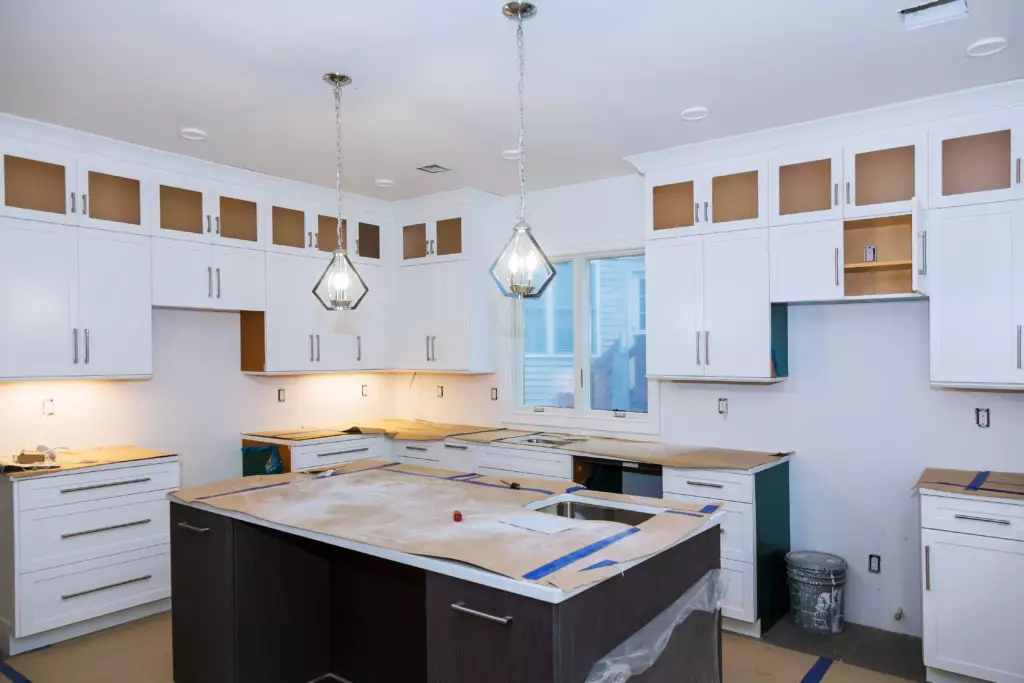So, you’ve been thinking about remodeling your kitchen for a while now.
The Pinterest boards are filled with dreamy designs, and you can almost smell the freshly baked cookies wafting from your future oven.
But, reality hits hard when you start crunching the numbers. How do you achieve that magazine-worthy kitchen without breaking the bank?
Easy — be a kitchen remodeling budget master.
Like most households, having a non-functional kitchen is just the reality. You walk into the room, and instead of feeling inspired, you’re greeted by outdated cabinets, worn countertops, and a faucet that seems to have seen better days.
The desire for a kitchen transformation is there, but so is the concern about the hefty price tag attached to it.
Whether you’re planning a minor facelift or a full-blown renovation, budgeting is the cornerstone of a successful project. It’s not just about crunching numbers; it’s about setting the stage for a stress-free and satisfying remodeling experience.
By establishing realistic expectations from the get-go, you’ll avoid the dreaded sticker shock and be closer to a vision that aligns with your financial reality.
And guess what? We’ve got just the tool to help you stay on track—the trusty budget planner template.
So, grab your apron, and let’s whip up a budget that’s as satisfying as your favorite dish.
1. Think about your needs and wants
Assessing your needs and wants for that dream kitchen of yours is like creating a recipe; you need to know your ingredients before you start cooking.


First things first, what are your must-haves versus nice-to-haves?
Picture yourself in your new kitchen—are there specific features or elements you simply can’t live without? Perhaps it’s enough storage space to declutter your countertops or a sleek island for meal prep and casual gatherings. These are your needs—the essentials that will make your kitchen functional and practical.
Now, let’s sprinkle in a dash of desire.
What are your wants—the cherry on top of your kitchen renovation sundae? Maybe you’ve been drooling over those checkered floors you spotted on Instagram or dreaming of installing a farmhouse sink straight out of a home design magazine. These are the elements that will elevate your kitchen’s aesthetic and reflect your personal style.
But, here’s the kicker: kitchen remodeling budget constraints.
We can’t all have a kitchen straight out of a celebrity home tour, but that doesn’t mean you can’t have a space that makes you swoon. It’s all about prioritizing your preferences within your budget.
Start by allocating funds to your must-haves, making sure that the essentials are covered before indulging in the extras. Remember, compromise doesn’t mean sacrificing style—it means making thoughtful decisions that align with your financial reality.
2. Research average costs
Now that you’ve got a handle on your kitchen needs and wants, it’s time to get down to brass tacks—researching the average costs of kitchen remodeling projects.
Start by casting a wide net and gathering information from various sources:
From contractor estimates
Contractor estimates are a valuable starting point, providing insight into the labor and material costs associated with different aspects of your remodel. Don’t hesitate to contact multiple contractors to compare quotes and get a sense of the price range for your project.
From online calculators
Online calculators are also great tools when it comes to estimating costs and budgeting effectively. These handy tools allow you to input specific details about your project, such as square footage and desired features, and receive an estimate tailored to your needs.
From industry reports
Additionally, don’t overlook industry reports and studies that offer valuable insights into prevailing trends and pricing dynamics in the world of kitchen remodeling.
These resources can help you stay informed about market trends, regional variations, and material prices, giving you a more comprehensive understanding of the cost landscape.
When researching average costs, it’s important to factor in regional variations and material prices. What may be considered affordable in one area could be expensive in another.
Researching average costs lays the foundation for informed decision-making and empowers you to make smart choices that align with your financial goals.
3. Set a realistic kitchen remodeling budget range
Based on your research, establish a budget range that considers both your needs and wants while allowing room for unexpected expenses.


Remember, a budget range provides flexibility and adaptability, allowing you to be prepared for any curveballs that may come your way during the remodeling process.
When determining your budget range, take into account your comfort level with spending and your long-term financial goals. Be honest with yourself about what you can afford and resist the temptation to stretch beyond your means.
Sure, you may want wall-to-wall cabinetry, but if your budget doesn’t have space for them, it is best reserved for the future. At the end of the day, setting a realistic budget range isn’t about restricting yourself; it’s about making informed choices that align with your financial reality.
Pro tip: It’s always wise to build a buffer for unexpected expenses. Whether it’s a surprise plumbing issue or a last-minute design change, having a safety fund will give you peace of mind and prevent budgetary headaches.
Ultimately, setting a realistic budget range is about striking a balance between your dreams and your financial constraints. By approaching budgeting with flexibility and foresight, you’ll set yourself up for success and ensure a smoother, more satisfying remodeling experience.
4. Factor in contingency funds
When setting your budget, it’s key to allocate a portion—ideally 10-20%—for contingencies.
This cushion allows you to handle unforeseen expenses without derailing your entire project. After all, Murphy’s Law has a way of making its presence known, especially when it comes to home renovations.
So, what exactly constitutes an unforeseen expense?
From unexpected structural repairs to design changes that require additional materials or labor, there’s no shortage of surprises that can crop up along the way. By setting aside a buffer, you’ll be prepared to tackle these challenges head-on without sacrificing your vision or blowing your budget.
5. Seek multiple quotes
Start by reaching out to multiple contractors and suppliers to request quotes for your project.


Best to begin with a big search and gather quotes from at least three to five different sources to get a more complete view of the market and pricing landscape. This will give you a sense of the range of costs for your remodel and empower you to make informed decisions about where to allocate your budget.
When evaluating quotes, don’t just focus on the bottom line—take a closer look at the scope of work and the details included in each proposal.
Pay attention to factors such as materials, labor costs, and project timelines to ensure you’re comparing apples to apples. Additionally, verify the credentials and reputation of each contractor or supplier to ensure they’re qualified and reliable.
Don’t be afraid to negotiate pricing and ask for discounts or incentives.
Remember, contractors and suppliers are often willing to work with you to win your business, especially in a competitive market. Use your research and leverage it to your advantage, and don’t settle for the first quote that comes your way.
By seeking multiple quotes and taking a strategic approach to evaluation and negotiation, you’ll maximize your budget and ensure a successful, cost-effective remodel.
Kitchen remodel budgeting with confidence
From assessing your needs and wants to factoring in contingency funds, each key factor plays an important role in setting realistic kitchen remodeling budget expectations and working towards a successful remodel.
By embracing the budgeting process and arming yourself with knowledge and preparation, you’re not just planning for a kitchen remodel—you’re laying the foundation for a transformative and rewarding experience. And with the help of our budget planner template, you’ll have a practical tool at your fingertips to guide you through every step of the journey.
So, as you embark on this exciting adventure, remember that budgeting isn’t just about crunching numbers—it’s about empowering yourself to make informed decisions, prioritizing your goals, and achieving your vision for the perfect kitchen.






